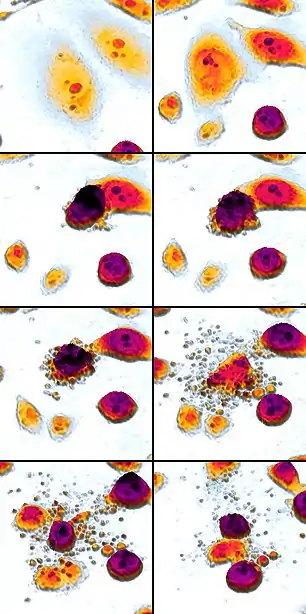DU145
DU145 (DU-145) is a human prostate cancer cell line.[1] DU145, PC3, and LNCaP are considered to be the standard prostate cancer cell lines used in therapeutic research.[1]
The DU145 cell line was derived from a central nervous system metastasis, of primary prostate adenocarcinoma origin, removed during a parieto-occipital craniotomy of a 69-year-old, White, male.[2][3] DU145 are not hormone-sensitive and do not express prostate-specific antigen (PSA). DU145 cells have moderate metastatic potential compared to PC3 cells, which have high metastatic potential.[4]
Research on castration-resistant prostate cancer
Castration-resistant prostate cancer (CRPC) is prostate cancer that progresses despite extremely low testosterone in the body often due to medical castration.[5] Unlike many other types of prostate cancer, CRPC do not need normal testosterone levels, but they still require regular androgen receptors (AR).[6]
Effects of NEK6 alteration
NEK6 inhibition is a potential treatment for CRPC due to its role as an essential protein kinase in the mitotic cell cycle. Although specific pathways remain unclear, deactivating the NEK6 gene is able to decrease clonogenic capacity, proliferation, cell viability, and mitochondrial activity. Additionally, intracellular ROS is increased and antioxidant defenses including SOD1, SOD2, and PRDX3 are decreased. SOD1, SOD2, and PRDX3 are known to be pro-oncogenic and be involved in chemotherapy resistance.[7] Overall, altering NEK6 leads to DNA damage and death of DU-145 cells through changes in the redox balance and DNA damage response.[8]
Effects of Xanthium fruit extracts
The compound 8-Epi-xanthatin (EXT) is an extract from Xanthium fruit and is used as a natural transcription 3 (STAT3) inhibitor to induce apoptotic cell death and decrease DU-145 cancer cell proliferation.[9] DU-145 cells consistently express activated STAT3 and required STAT3 activity for proliferation and survival. However, EXT can be used as an anti-cancer therapeutic as the toxicity to normal cells (MCF10A and HFF) is lower than to DU-145. STAT3 regulates proliferation of cancer cells through target genes, including cyclin A, cyclin D1, and antiapoptotic proteins, such as BCL-2, and BCL-xL. After treatment of DU-145 with EXT, the aforementioned genes are strongly suppressed, ROS production increased, and cancer cell apoptosis was increased.
References
- Alimirah, Fatouma; Chen, Jianming; Basrawala, Zane; Xin, Hong; Choubey, Divaker (2006-04-17). "DU-145 and PC-3 human prostate cancer cell lines express androgen receptor: Implications for the androgen receptor functions and regulation". FEBS Letters. 580 (9): 2294–2300. doi:10.1016/j.febslet.2006.03.041. PMID 16580667. S2CID 21777101.
- "DU 145 - HTB-81 | ATCC". www.atcc.org. Retrieved 2023-04-18.
- Stone, Kenneth R.; Mickey, Don D.; Wunderli, Heidi; Mickey, George H.; Paulson, David F. (1978-03-15). "Isolation of a human prostate carcinoma cell line (DU 145)". International Journal of Cancer. 21 (3): 274–281. doi:10.1002/ijc.2910210305. PMID 631930. S2CID 26978561.
- Pulukuri, Sai MuraliKrishna; Gondi, Christopher S.; Lakka, Sajani S.; Jutla, Aman; Estes, Norman; Gujrati, Meena; Rao, Jasti S. (2005-10-28). "RNA Interference-directed Knockdown of Urokinase Plasminogen Activator and Urokinase Plasminogen Activator Receptor Inhibits Prostate Cancer Cell Invasion, Survival, and Tumorigenicity in Vivo*". Journal of Biological Chemistry. 280 (43): 36529–36540. doi:10.1074/jbc.M503111200. ISSN 0021-9258. PMC 1351057. PMID 16127174.
- "Definition of castrate-resistant prostate cancer". National Cancer Institute Dictionary of Cancer Terms. 2011-02-02. Retrieved 2023-09-12.
- Chandrasekar, Thenappan; Yang, Joy C.; Gao, Allen C.; Evans, Christopher P. (June 2015). "Mechanisms of resistance in castration-resistant prostate cancer (CRPC)". Translational Andrology and Urology. 4 (3): 36580–36380. doi:10.3978/j.issn.2223-4683.2015.05.02. ISSN 2223-4691. PMC 4708226. PMID 26814148.
- Ramasamy, Pathma; Larkin, Anne-Marie; Linge, Annett; Tiernan, Damien; McAree, Fionnuala; Horgan, Noel; Moriarty, Paul; Beatty, Stephen; Murphy, Conor C.; Clynes, Martin; Kennedy, Susan; Meleady, Paula (2020-07-01). "PRDX3 is associated with metastasis and poor survival in uveal melanoma". Journal of Clinical Pathology. 73 (7): 408–412. doi:10.1136/jclinpath-2019-206173. ISSN 0021-9746. PMID 31771972. S2CID 208321379.
- Pavan, Isadora Carolina Betim; Basei, Fernanda Luisa; Severino, Matheus Brandemarte; Rosa e Silva, Ivan; Issayama, Luidy Kazuo; Mancini, Mariana Camargo Silva; Góis, Mariana Marcela; da Silva, Luiz Guilherme Salvino; Bezerra, Rosangela Maria Neves; Simabuco, Fernando Moreira; Kobarg, Jörg (January 2023). "NEK6 Regulates Redox Balance and DNA Damage Response in DU-145 Prostate Cancer Cells". Cells. 12 (2): 256. doi:10.3390/cells12020256. ISSN 2073-4409. PMC 9856815. PMID 36672191.
- Lee, Yu‐Jin; Choi, Jiyeon; Yoon, Yae Jin; Sim, Yugyeong; Ryu, Hyung Won; Oh, Sei‐Ryang; Kim, Doo‐Young; Hwang, Jihyun; Chi, Seung‐Wook; Han, Dong Cho; Kwon, Byoung‐Mog (March 2021). "8‐Epi‐xanthatin induces the apoptosis of DU145 prostate carcinoma cells through signal transducer and activator of transcription 3 inhibition and reactive oxygen species generation". Phytotherapy Research. 35 (3): 1508–1520. doi:10.1002/ptr.6918. ISSN 0951-418X. PMID 33164240. S2CID 226284947.
